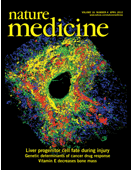 Almost a decade ago, the US National Institutes of Health kicked off its Molecular Libraries Initiative to provide academic researchers with access to the high-throughput screening tools needed to identify new therapeutic compounds. Europe now seems keen on catching up.
Almost a decade ago, the US National Institutes of Health kicked off its Molecular Libraries Initiative to provide academic researchers with access to the high-throughput screening tools needed to identify new therapeutic compounds. Europe now seems keen on catching up.
Last month, the Innovative Medicines Initiative (IMI), a €2 billion ($2.6 billion) Brussels-based partnership between the European Commission and the European Federation of Pharmaceutical Industries and Associations (EFPIA), invited proposals to build a molecular screening facility for drug discovery in Europe that will combine the inquisitiveness of academic scientists with industry know-how. The IMI’s call for tenders says the facility will counter “fragmentation” between these sectors.
The IMI will offer €80 million over five years to the consortium selected to build up and manage a centralized screening infrastructure and a library of up to 500,000 compounds. Expressions of interest from qualified academic-industry partnerships are due in mid-May.
Major pharmaceutical companies have more experience with high-throughput screening than do most academic institutes. Yet companies often limit tests of their closely held candidate chemicals to a fraction of potential disease targets. By pooling chemical libraries and screening against a more diverse set of targets—and identifying more molecular interactions—both academics and pharmaceutical companies stand to gain, says Hugh Laverty, an IMI project manager.
The IMI already has commitments from seven members of the EFPIA to contribute 50,000 compounds each, and future academic partners are expected to donate between 100,000 and 200,000 total. (The NIH similarly has around 300,000 chemically diverse compounds in its small-molecule repository.)
Onlookers note the challenge of handling so many molecular candidates. Whoever manages the IMI’s ‘European Screening Centre’ will need to develop an efficient process for preselecting compounds to make the high-throughput screening worth the cost to taxpayers, says Robert Damoiseaux, scientific director of the Molecular Screening Shared Resource (MSSR) at the University of California–Los Angeles. Damoiseaux recommends that Europeans look across the pond for insight on this: “It’s certainly really useful to compare notes with American researchers and have a look at which lessons can be learned, what paradigms worked and what didn’t.”
Ultimately, a facility as large as the proposed European Screening Center should be more efficient than the smaller sites that already exist around Europe, says Gerardo Turcatti, who directs the Biomolecular Screening Facility at the Swiss Federal Institute of Technology in Lausanne. He adds, however, that sorting out intellectual property in any collaboration that also involves industrial applications will be a challenge.
Laverty says the IMI will help the winning consortium negotiate the particulars with the industry partners. “We’re very aware of intellectual property concerns,” he explains, adding that identifying a promising compound might trigger milestone payments to a compound’s contributor.